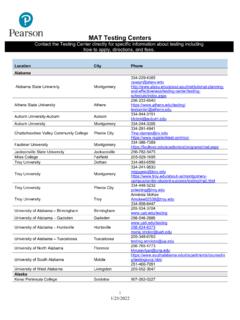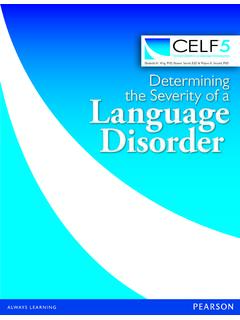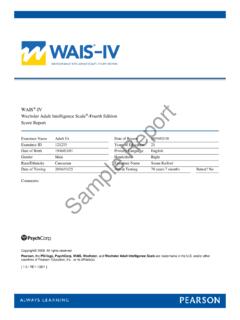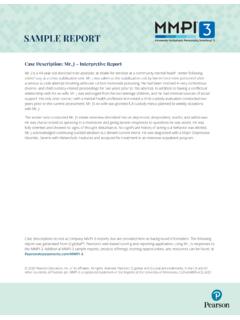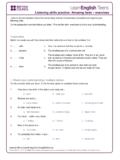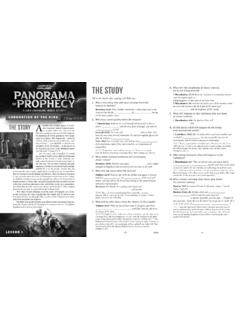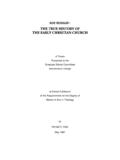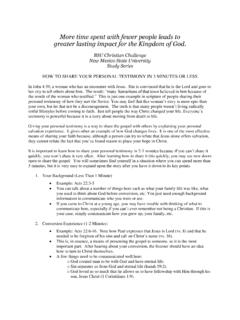Transcription of Developmental Indicators for the ... - Pearson Assessments
1 Developmental Indicators for the Assessment of Learning, Fourth Edition (DIAL-4)Carol Mardell, PhD Dorothea S. Goldenberg, EdDUsers and applicationsDIAL-4 is used by preschool and kindergarten teachers, early childhood specialists, child development center personnel, Head Start programs, and program administrators. As you champion the success and progress of young children, you appreciate what each one does to build on their individual strengths and talents. By teaching and discovering new ways to engage young learners, you encourage them to participate in activities that bring out the best in each of them. A child s first years are a time of amazing growth, and early childhood professionals like you can have a tremendously positive impact on each learner s success both in and out of school.
2 Research indicates that the earlier we intervene, the more impactful those interventions will be, setting the child up for success throughout their s Developmental screening instruments are designed by early childhood experts like you, and include child-friendly Indicators for the Assessment of Learning, Fourth Edition (DIALTM-4) is a global screener for assessing large groups of children quickly and efficiently. It provides standard deviation and percentile cutoff points by chronological age at two-month intervals for total and area scores Motor, Concepts, Language, Self-Help, and Social Development. Percentile ranks and standard scores are also and administrationDIAL-4 is administered in a one-to-one setting.
3 Use the tool by presenting stimuli one at a time using manipulatives and other materials. The results are comprehensive and provide an overall picture for all five early childhood areas. Motor area Gross Motor items include catching, jumping, hopping, and skipping. Fine Motor items include building with blocks, cutting, copying shapes and letters, writing, and a popular finger touching developmentLooks at the child s development of social skills with other children and parents, including rule compliance, sharing, self-control, and areaItems include answering simple personal questions (name, age, and sex), articulation, naming (expressive) or identifying (receptive) objects and actions, plus phonemic awareness tasks such as rhyming and I Spy.
4 Concepts areaItems include pointing to named body parts, naming or identifying colors, rote counting, counting blocks, identifying concepts in a triad of pictures, and sorting shapes. Includes an item that assesses automatic naming of objects, a skill that is associated with potential learning developmentLooks at the child s development of personal care skills related to dressing, eating, and and benefitsIn partnership with the authors of DIAL, the fourth edition was designed with today s technologically savvy children and classroom needs in mind to help save time in administration and receipt of the results. New norms to support updated edition Lowered floor from 3:0 to 2.
5 6 New items to measure skills important for predicting academic success Reformatted Handbooks and Record Form for easier administration and scoring Simplified administration instructions and scoring rules to reduce errors Teacher Questionnaire allowing for information from multiple sourcesMaterials Manual Easy-to-follow Operator s Handbooks Lightweight, one-piece dials Separate zippered bags for the area materials Easy-to-use carrying bag Teacher Questionnaire Offers the opportunity for teacher feedback Parent Questionnaire Helps gather information about the child s health history, background, and development of self-help and social skills Report to Parents Helps facilitate discussion with parents and caregivers about their child s progress Optional Parent-Child Activity Form Suggests activities parents can use to help their child improve motor, language, concepts, self-help, and social skillsSpeedDIAL-4 Save time with a shortened version of DIAL-4.
6 Speed DIAL is appropriate for quick screening in smaller settings such as departments of public health, pediatric offices, health fairs, homes, and and reporting Early intervention is key for students who may need more assistance, and having quick access to the results of an assessment helps to inform a student s academic plan. DIAL-4 provides scoring and reporting options that best fit your environment. You can choose between manual paper-and-pencil scoring or digital scoring using our web-based SUMMARYThe Developmental Indicators for the Assessment of Learning , Fourth Edition (DIAL -4) is an individually administered Developmental screening test designed to identify young children who need further testing or who need help with academic skills.
7 The DIAL-4 tests a child s motor skills (skipping, jumping, cutting, writing), conceptual skills (knowledge of colors, counting), and language skills (knowledge of letters and words, ability to solve problems). In addition, the Parent and Teacher Questionnaires measure a child s self-help skills (dressing, feeding, bathing) and social-emotional skills (getting along with others, staying on task).The skills measured by the DIAL-4 are proven to help predict a child s success in the classroom. The DIAL-4 screening test can help parents and teachers decide if a child s skills are appropriate for his/her age or if further testing or interventions are needed. This information can help with planning the child s education and, if necessary, can help parents and teachers address any needs the child may have at home or in school.
8 The DIAL-4 provides scores that show how the child s Developmental skills compare with those of a national norm group a group of typical children from across the United States who are the same age as the child. The table below lists Jackson Sample s AreasDecisionStandard ScoreIntelligibilityPercentileNational PercentileCutoff LevelOK/Potential DelayMotor16%OK105OK64 ConceptsOK96OK39 LanguageOK96 Poor39 DIAL-4 TotalOK9845 Beh. Obs. (Cutoff Level 7%)7%Potential Delay10 25 50 75 99ID: 7654321 Jackson SampleQuestionnairesDecisionStandard ScorePercentileNational PercentileCutoff LevelOK/Potential DelayParent QuestionnaireSelf-Help Development (PQ)16%OK9639 Social-Emotional Development (PQ)OK10153 Teacher QuestionnaireSelf-Help Development (TQ)16%Potential Delay809 Social-Emotional Development (TQ)OK892410 25 50 75 99 Score ReportSample Score Report (English) 5 RESUMEN de PUNTUACI NDevelopmental Indicators for the Assessment of Learning , Fourth Edition (DIAL -4) (Indicadores del desarrollo para la evaluaci n del aprendizaje-Cuarta edici n)
9 Es una prueba, administrada de manera individual, que est dise ada para evaluar el desarrollo e identificar a ni os peque os que necesiten de m s evaluaci n o ayuda con sus destrezasacad micas. La DIAL-4 eval a habilidades motoras (saltar, brincar, cortar, escribir), conceptuales (conocimiento de colores, conteo) y ling sticas (conocimiento de letras y palabras, habilidad para resolver problemas). Adem s, los Cuestionarios para los padres y para maestros miden habilidades de autoayuda (vestirse, alimentarse, ba arse) ysocio-emocionales (llevarse bien con otros, mantenerse enfocado en una tarea) de un ni o(a).Se ha demostrado que las habilidades medidas por la DIAL-4 ayudan a predecir el xito de un ni o(a) en la escuela.
10 La prueba DIAL-4 puede ayudar a los padres y maestros a decidir si las habilidades de un ni o(a) son apropiadas para su edad o si se necesitan evaluaciones o intervenciones adicionales. Esta informaci n puede ayudarles a planear laeducaci n del ni o(a) y, si es necesario, atender cualquier necesidad que el ni o(a) pudiera tener en casa o en la escuela. La DIAL-4 provee puntuaciones que muestran c mo las habilidades del ni o(a) se comparan con las de un grupo normativo nacional-un grupo de ni os t picos de todas partes de los Estados Unidos que tienen la misma edad que el ni o(a). La tabla que aparece a continuaci n presenta las puntuaciones de Jackson de rendimientoDecisi nPuntuaci n Est ndarInteligibilidadPercentilPercentil nacionalNivel de CorteOK/Posible retrasoMotora16%OK105OK64 ConceptosOK96OK39 LenguajeOK96 Malo39 DIAL-4 prueba totalOK9845 Observaciones de comportamiento7%Posible retraso10 25 50 75 99 CuestionariosDecisi nPuntuaci n Est ndarPercentilPercentil nacionalNivel de CorteOK/Posible retrasoCuestionario para los padresDesarrollo de autoayuda16%OK9639 Desarrollo socio-emocionalOK10153 Cuestionario para maestrosDesarrollo de autoayuda16%Posible retraso809 Desarrollo

